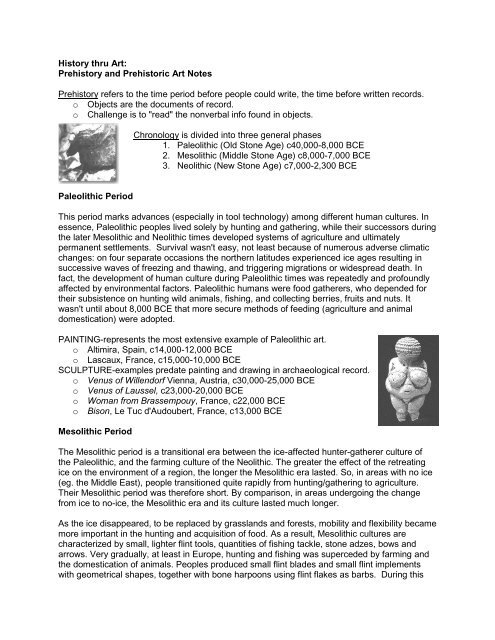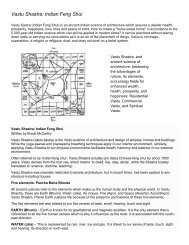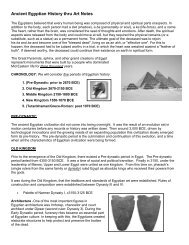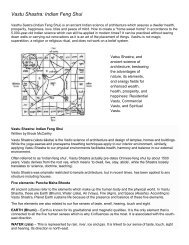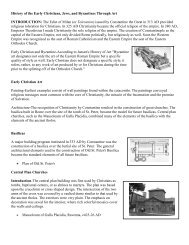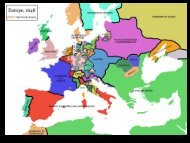Prehistory notes.pdf - DMHScommunity
Prehistory notes.pdf - DMHScommunity
Prehistory notes.pdf - DMHScommunity
You also want an ePaper? Increase the reach of your titles
YUMPU automatically turns print PDFs into web optimized ePapers that Google loves.
History thru Art:<br />
<strong>Prehistory</strong> and Prehistoric Art Notes<br />
<strong>Prehistory</strong> refers to the time period before people could write, the time before written records.<br />
o Objects are the documents of record.<br />
o Challenge is to "read" the nonverbal info found in objects.<br />
Chronology is divided into three general phases<br />
1. Paleolithic (Old Stone Age) c40,000-8,000 BCE<br />
2. Mesolithic (Middle Stone Age) c8,000-7,000 BCE<br />
3. Neolithic (New Stone Age) c7,000-2,300 BCE<br />
Paleolithic Period<br />
This period marks advances (especially in tool technology) among different human cultures. In<br />
essence, Paleolithic peoples lived solely by hunting and gathering, while their successors during<br />
the later Mesolithic and Neolithic times developed systems of agriculture and ultimately<br />
permanent settlements. Survival wasn't easy, not least because of numerous adverse climatic<br />
changes: on four separate occasions the northern latitudes experienced ice ages resulting in<br />
successive waves of freezing and thawing, and triggering migrations or widespread death. In<br />
fact, the development of human culture during Paleolithic times was repeatedly and profoundly<br />
affected by environmental factors. Paleolithic humans were food gatherers, who depended for<br />
their subsistence on hunting wild animals, fishing, and collecting berries, fruits and nuts. It<br />
wasn't until about 8,000 BCE that more secure methods of feeding (agriculture and animal<br />
domestication) were adopted.<br />
PAINTING-represents the most extensive example of Paleolithic art.<br />
o Altimira, Spain, c14,000-12,000 BCE<br />
o Lascaux, France, c15,000-10,000 BCE<br />
SCULPTURE-examples predate painting and drawing in archaeological record.<br />
o Venus of Willendorf Vienna, Austria, c30,000-25,000 BCE<br />
o Venus of Laussel, c23,000-20,000 BCE<br />
o Woman from Brassempouy, France, c22,000 BCE<br />
o Bison, Le Tuc d'Audoubert, France, c13,000 BCE<br />
Mesolithic Period<br />
The Mesolithic period is a transitional era between the ice-affected hunter-gatherer culture of<br />
the Paleolithic, and the farming culture of the Neolithic. The greater the effect of the retreating<br />
ice on the environment of a region, the longer the Mesolithic era lasted. So, in areas with no ice<br />
(eg. the Middle East), people transitioned quite rapidly from hunting/gathering to agriculture.<br />
Their Mesolithic period was therefore short. By comparison, in areas undergoing the change<br />
from ice to no-ice, the Mesolithic era and its culture lasted much longer.<br />
As the ice disappeared, to be replaced by grasslands and forests, mobility and flexibility became<br />
more important in the hunting and acquisition of food. As a result, Mesolithic cultures are<br />
characterized by small, lighter flint tools, quantities of fishing tackle, stone adzes, bows and<br />
arrows. Very gradually, at least in Europe, hunting and fishing was superceded by farming and<br />
the domestication of animals. Peoples produced small flint blades and small flint implements<br />
with geometrical shapes, together with bone harpoons using flint flakes as barbs. During this
time, Northern Europe was a bone and horn culture, producing flint scrapers, borers and coreaxes.<br />
Artistically, the human figure was represented in groups rather than the<br />
single figure of the Paleolithic. The technique used was probably<br />
spitting or blowing the pigments onto the rock. The paintings are quite<br />
naturalistic, though stylized. The figures are not three-dimensional, even<br />
though they overlap.<br />
o Marching Warriors, Castellon, Spain, c7000-4000 BCE<br />
Neolithic Period<br />
The Neolithic era witnessed a fundamental change in lifestyle across Europe. OUT went the<br />
primitive semi-nomadic style of hunting and gathering food, IN came a much more settled form<br />
of existence, based on farming and rearing of domesticated animals. Neolithic culture was<br />
characterized by stone tools shaped by polishing or grinding, and farming (staple crops: wheat,<br />
barley and rice; domesticated animals: sheep, goats, pigs and cattle), and led directly to a<br />
growth in crafts like pottery and weaving. All this began about 9,000 BCE in the villages of<br />
southern Asia, after which it flourished in the fertile crescent of the Tigris and Euphrates river<br />
valleys in the Middle East (c.7,000 BCE), before spreading to India (c.5,000 BCE), Europe<br />
(c.4,000 BCE), China (3,500 BCE) and the Americas (independently) (c.2,500 BCE).<br />
The establishment of settled communities (villages, towns and in due course cities) triggered a<br />
variety of new activities, notably: a rapid stimulation of trade, the construction of trading vehicles<br />
(mainly boats), new forms of social organizations, along with the growth of religious beliefs and<br />
associated ceremonies. And due to improvements in food supply and environmental control,<br />
the population rapidly increased. For tens of millennia before the advent of agriculture, the total<br />
human population had varied between 5 million and 8 million. By 4000 BCE, after less than<br />
5,000 years of farming, numbers had risen to 65 million.<br />
In general, the more settled and better resourced the region, the more art it<br />
produces. So it was with the Neolithic period. And although most ancient Neolithic<br />
art remained essentially functional in nature, there was a greater focus on<br />
ornamentation and decoration. For instance, cuneiform, hieroglyphics, and<br />
calligraphy first appear during the Neolithic.<br />
The emergence of the first city state (Uruk, in Mesopotamia) predicts the<br />
establishment of more secure communities around the world, creating permanent<br />
large-scale works of architecture in the process. The Neolithic age also saw the emergence of<br />
monumental public art in the form of the Egyptian pyramid architecture, as well as assemblages<br />
of large upright stones (called menhirs or megaliths: Megaliths-Greek-Megas, made from huge<br />
stones without mortar) such as those of Stonehenge and Avebury Circle, and complex<br />
subterranean tombs like that of Newgrange, whose entrance stone incised with a complex<br />
design of spirals.<br />
o Carnac, France, c3,000 BCE<br />
o Stonehenge, England, c2750-1500 BCE<br />
NOTE: Later periods of history in addition to the Stone Age include the Bronze Age (c3000-<br />
1200 BCE) and Iron Age (c1500-200 BCE) in Europe.


